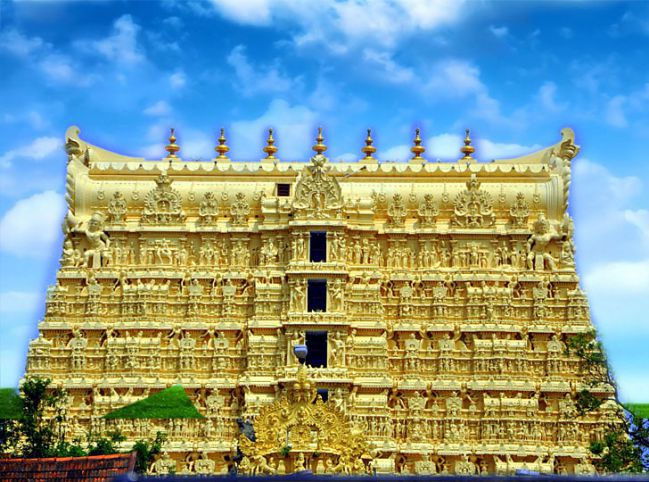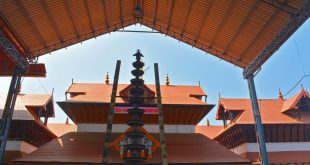
Anantha Padmanabhaswamy Temple
Anantha Padmanabhaswamy Temple Trivandrum – History, Timings, Pooja Details, Offerings, Festivals, Accommodation, Seva Prices & Timings, Festivals, Online Booking, How To Reach
Padmanabhaswamy Temple Trivandrum History
The history of the Sree Padmanabhaswamy Temple in Thiruvananthapuram, Kerala, is rich and spans several centuries.
Ancient Roots: The temple’s origins are ancient, dating back over a thousand years. It is believed to have been constructed during the reign of the Chera dynasty, which ruled over Kerala in the 6th century CE. The temple’s primary deity, Lord Padmanabha, is a form of Lord Vishnu.
Marumakkathayam System: The temple’s history is closely tied to the Marumakkathayam system, a matrilineal system of inheritance in Kerala. The temple was maintained and administered by the Ettuveettil Pillais, a prominent Nair family, under the system.
Travancore Royal Patronage: In the 18th century, the Travancore royal family assumed control of the temple, and it became a significant center of their patronage. The temple’s administration was restructured, and the royal family played a pivotal role in its development and preservation.
Marthanda Varma’s Renovation: Maharaja Marthanda Varma of Travancore (reigned 1729–1758) played a crucial role in renovating and rebuilding the temple. He is often credited with the construction of the current sanctum sanctorum, known as the “sreekovil,” and the massive temple tower (gopuram).
Temple Architecture: The temple’s architecture is a blend of the traditional Dravidian style and Kerala architectural elements. The intricate carvings and sculptures on the temple tower and inner sanctum reflect the rich cultural heritage of the region.
Religious Significance: The temple has been a significant spiritual center for devotees of Lord Vishnu. It is renowned for the deity’s unique reclining posture, with Lord Padmanabha’s right hand extended in a blessing. Pilgrims from across India visit the temple to seek blessings and perform rituals.
Treasure Discovery: In 2011, the temple gained international attention when a vast treasure trove of gold, jewels, and valuable artifacts was discovered in its underground vaults. This discovery added to the temple’s historical and cultural significance.
Renovation and Preservation: Over the years, the temple has undergone several renovation and preservation projects to maintain its structural integrity and preserve its historical and religious importance.
Cultural Impact: The Sree Padmanabhaswamy Temple has had a profound impact on Kerala’s culture, art, and music. It is an iconic symbol of the state’s heritage and spirituality.
Legal and Administrative Changes: With the treasure discovery, legal and administrative changes occurred. The temple administration, along with the Travancore royal family, continued to manage the temple’s affairs.
Architecture and Design:
Describe the architectural style of the temple, which is a fine example of the Dravidian style with strong influences from Kerala architecture.
Explain the significance of the 16th-century Gopuram (temple tower) and its intricate carvings.
Mention the temple’s layout, including the sanctum sanctorum (sreekovil), the corridor, and other architectural features.
Spiritual Significance:
Explain the religious importance of the temple and its connection to Lord Padmanabha, an incarnation of Lord Vishnu.
Discuss the rituals and daily ceremonies performed at the temple.
Highlight the annual festivals, including the Laksha Deepam festival, which is famous for lighting thousands of oil lamps.
Padmanabhaswamy Temple Trivandrum Timings
| Morning: 3.00 am to 1.00 pmEvening: 3.30 pm to 9.00 pm |
Padmanabhaswamy Temple Darshan Timings
| Morning | Evening |
| 03.30 am to 04.45 am
(Nirmalya Darshanam) | 05.00 pm to 06.15 pm |
| 06.30 am to 07.00 am | 06.45 pm to 07.20 pm |
| 08.30 am to 10.00 am | |
| 10.30 am to 11.10 am | |
| 11.45 am to 12.00 Noon | |
| Note : These Timings may change during
Special Days |
Padmanabhaswamy Temple Rituals
Main Pooja :
NIRMALYAM TO Deeparadhana | |
| Pooja | 3.30am to 4.45am |
| Darshan | 03.30am to 04.45am |
| No. of Persons allowed | 2 |
| Cost | Rs 3000/- |
Nirmalyam to Usha pooja | |
| Pooja | 3.30am to 5.30am |
| 3.30am to 5.30am | 03.30am to 04.45am |
| No. of Persons allowed | 2 |
| Cost | Rs 4000/- |
Nirmalyam to pantheeradi pooja | |
| Pooja | 3.30am to 6.00am |
| Darshan | 03.30am to 04.45am |
| No. of Persons allowed | 2 |
| Cost | Rs 5000/- |
Nirmalyam to Ucha pooja | |
| Pooja | Half Day |
| No. of Persons allowed | 4 |
| Cost | Rs 12000/- |
Padmanabhaswamy Temple Other Poojas / Offerings:
Choroonu(Feeding a child for the 1st time) | |
| Cost | Rs 100/- |
Annaprasadam(Food Donation) | |
| Cost | Rs 15000/- per day |
Vidyarambham (Veda Vyasar)Commencement Of Education | |
| Cost | Rs 50/- |
Aval (Sreerama Swamy) | |
| Cost | Rs 30/- |
| Prasadam Issue (Timing) | 8.30 am to 10.30 am |
Agarshala Ganapathy | |
| Astothara Archana (Ganapathy)
Cost | Rs 20/- |
| Prasadam issue(Timings) | “Same timings of Darshan”
except 3.30 am to 4.45 pm |
| Sreemaha Ganapathy Homam Cost | Rs 200/- |
| Prasadam issue Timings | 6.30 am to 10.00 am |
| Modakam (Ganapathy) Cost | Rs 120/- |
| Prasadam issue Timings | 5.00 pm to 7.00 pm |
Sree Sastha | |
| Astothara Archana (Sastha) | Rs 20/- |
| Prasadam issue Timings | “Same timing of Darshan”
except 3.30 am to 4.45am |
| Neeranjanam (Sastha) | Rs 30/- |
| Prasadam issue Timings | “Same timing of Darshan”
except 3.30 am to 4.45am |
| Panakam (Sastha) | Rs 30/- |
| Prasadam issue Timings | “Same timing of Darshan”
except 3.30 am to 4.45am |
| Ney Vilakku (Sastha) | Rs 50/- |
| Prasadam issue Timings | “Same timing of Darshan”
except 3.30 am to 4.45am |
Sree Krishna Swamy | |
| Astothara archana (Krishnaswamy) | Rs 20/- |
| Sahasranama Archana (Krishnaswamy) | Rs 30/- |
| Bhagyasooktha archana (Krishnaswamy) | Rs 30/- |
| Aikyamathya sooktham (Krishnaswamy) | Rs 30/- |
| Santhanagopala Archana (Krishnaswamy) | Rs 30/- |
| Vidyarajagopala archana (Krishnaswamy) | Rs 30/- |
| Swayamvara Archana (Krishnaswamy) | Rs 30/- |
| Sudarshana Archana (Krishnaswamy) | Rs 30/- |
| Lekshminarayana manthra archana (Krishnaswamy) | Rs 30/- |
| Ney Vilakku (Krishnaswamy) | Rs 50/- |
| Palpayasam – 1 Litre (Krishnaswamy) | Rs 180/- |
| Timings | 8.30am to 10.30am |
| Palpayasam – 1/2 Litter (Krishnaswamy) | Rs 100/- |
| Timings | 8.30am to 10.30am |
| Aval (Krishnaswamy) | Rs 30/- |
| Timings | 8.30am to 10.30am |
Sree Narasimha Swamy | |
| Sathrudosha parihara archana (Narasimhaswamy) | Rs 50/- |
| Prasadam issue Timings | “Same timing of Darshan”
except 3.30 am to 4.45am |
| Dhanwanthary Archana (Narasimhaswamy) | Rs 30/- |
| Prasadam issue Timings | “Same timing of Darshan”
except 3.30 am to 4.45am |
| Sahasranama Archana (Narasimhaswamy) | Rs 30/- |
| Prasadam issue Timings | “Same timing of Darshan”
except 3.30 am to 4.45am |
| Ney Vilakku (Narasimhaswamy)”Lighting deepam with ghee” | Rs 50/- |
| Prasadam issue Timings | “Same timing of Darshan”
except 3.30 am to 4.45am |
| Bhagyasooktha archana (Narasimhaswamy) | Rs 30/- |
| Prasadam issue Timings | “Same timing of Darshan”
except 3.30 am to 4.45am |
| Sudarshana Archana (Narasimhaswamy) | Rs 30/- |
| Prasadam issue Timings | “Same timing of Darshan”
except 3.30 am to 4.45am |
| Panakam (Narasimhaswamy) | Rs 30/- |
| Palpayasam – 1 Litter (Narasimhaswamy) | Rs 180/- |
| Timings | 8.30 am to 10.30 am |
| Palpayasam – 1/2 Litter (Narasimhaswamy) | Rs 100/- |
| Timings | 8.30 am to 10.30 am |
| Aval (Narasimhaswamy) | Rs 30/- |
| Timings | 8.30 am to 10.30 am |
| Atta vilakku (Narasimhaswamy) | Rs 500/- |
| Prasadam issue Timings | “Same timing of Darshan”
except 3.30 am to 4.45am |
| Astothara Archana (Narasimhaswamy) | Rs 20/- |
| Prasadam issue Timings | “Same timing of Darshan”
except 3.30 am to 4.45am |
| Aikyamathya sooktham (Narasimhaswamy) | Rs 30/- |
| Prasadam issue Timings | “Same timing of Darshan”
except 3.30 am to 4.45am |
Sree PadmanabhaSwamy | |
| Meni thula payasam 1/8 unit (padmanabhaswamy) | Rs 1000/- |
| Prasadam issue | 8.30am to 10.30am |
| Otta thula payasam (Padmanabhaswamy) | Rs 500/- |
| Prasadam issue | 8.30am to 10.30am |
| Palpayasam – 1 Litter (Padmanabhaswamy) | Rs 180/- |
| Prasadam issue | 8.30am to 10.30am |
| Palpayasam – 1/2 Litter (Padmanabhaswamy) | Rs 100/- |
| Prasadam issue | 8.30am to 10.30am |
| Sarkara Payasam (Padmanabhaswamy) | Rs 60/- |
| Prasadam issue | 8.30am to 10.30am |
| Ney payasam (padmanabhaswamy) | Rs 80/- |
| Prasadam issue | 8.30am to 10.30am |
| Thrimaduram (padmanabhaswamy) | Rs 40/- |
| Prasadam issue | 8.30am to 10.30am |
| Pongal (padmanabhaswamy) | Rs 60/- |
| Prasadam issue | 8.30am to 10.30am |
| Unniyappam (padmanabhaswamy) | Rs 60/- |
| Prasadam issue | 7.45pm to 08.15pm |
| Aval (Padmanabhaswamy) | Rs 30/- |
| Prasadam issue | 8.30am to 10.30am |
| Aravana (padmanabhaswamy) | Rs 80/- |
| Prasadam issue | 7.45pm to 08.15pm |
| Ksheerabhishekam (padmanabhaswamy) Abishekam with Milk | Rs 100/- |
| Panchamritham
Abishekam with Panchamritham | Rs 60/- |
| Astothara Archana (Padmanabhaswamy) | Rs 20/- |
| Prasadam issue | “Same timing of darshan” except 3.30am to 4.45am |
| Sahasranama Archana (Padmanabhaswamy) | Rs 30/- |
| Prasadam issue | “Same timing of darshan” except 3.30am to 4.45am |
| Bhoosooktha Archana (Padmanabhaswamy) | Rs 30/- |
| Prasadam issue | “Same timing of darshan” except 3.30am to 4.45am |
| Vedamanthra Archana (Padmanabhaswamy) | Rs 30/- |
| Prasadam issue | “Same timing of darshan” except 3.30am to 4.45am |
| Purushasooktha Archana (Padmanabhaswamy) | Rs 30/- |
| Prasadam issue | “Same timing of darshan” except 3.30am to 4.45am |
| Sreesooktha Archana (Padmanabhaswamy) | Rs 30/- |
| Prasadam issue | “Same timing of darshan” except 3.30am to 4.45am |
| Bhagyasooktha Archana (Padmanabhaswamy) | Rs 30/- |
| Prasadam issue | “Same timing of darshan” except 3.30am to 4.45am |
| Aikyamathyasooktha Archana (Padmanabhaswamy) | Rs 30/- |
| Prasadam issue | “Same timing of darshan” except 3.30am to 4.45am |
| Vidyarajagopala Archana (Padmanabhaswamy) | Rs 30/- |
| Prasadam issue | “Same timing of darshan” except 3.30am to 4.45am |
| Swayamvara Archana (Padmanabhaswamy) | Rs 30/- |
| Prasadam issue | “Same timing of darshan” except 3.30am to 4.45am |
| Dhanwanthary Archana (Padmanabhaswamy) | Rs 30/- |
| Prasadam issue | “Same timing darshan” except 3.30am to 4.45am |
| Narayana sooktham (Padmanabhaswamy) | Rs 30/- |
| Prasadam issue | “Same timing of darshan” except 3.30am to 4.45am |
| Sudarshana Archana (Padmanabhaswamy) | Rs 30/- |
| Prasadam issue | “Same timing of darshan” except 3.30am to 4.45am |
| Lekshminarayanamanthra Archana (Padmanabhaswamy) | Rs 30/- |
| Prasadam issue | “Same timing of darshan” except 3.30am to 4.45am |
| Samvadasooktham (Padmanabhaswamy) | Rs 30/- |
| Prasadam issue | “Same timing of darshan” except 3.30am to 4.45am |
| Ney Vilakku (Padmanabhaswamy)
Lightening Lamp (Deepam) with Ghee | Rs 50/- |
| Meni thula payasam 1/16 unit (padmanabhaswamy) | Rs 500/- |
| Prasadam issue | 8.30am to 10.30am |
Here are some frequently asked questions (FAQs) related to the Padmanabhaswamy Temple:
- What is the significance of the Padmanabhaswamy Temple?
A. The Padmanabhaswamy Temple is significant as a revered Hindu temple dedicated to Lord Padmanabha, an incarnation of Lord Vishnu. It is known for its historical, cultural, and religious importance.
2. Are there any dress code requirements for visiting the temple?
A. Yes, there is a strict dress code for temple visitors. Men are required to wear dhotis (traditional attire), and women should wear sarees or salwar kameez. It’s important to adhere to these guidelines as a sign of respect.
3. Are mobile phones and electronic devices allowed inside the temple?
A. No, mobile phones and electronic devices are generally not allowed inside the temple. Visitors are often requested to deposit these items in designated storage facilities before entering the temple premises.
4. Is there an entry fee to visit the temple?
A. There may be an entry fee for visitors, and it could vary depending on the category (Indian or foreign tourist) and age group. It’s best to check the current fees before your visit.
5. What are the main festivals celebrated at the Padmanabhaswamy Temple?
A. The temple celebrates various festivals throughout the year, including the Panguni Uthiram festival and the annual Laksha Deepam festival, known for lighting thousands of oil lamps.
6. Is it compulsory to wear a dhoti at the Padmanabhaswamy Temple?
A. Yes, it is typically compulsory for male visitors to wear a dhoti while entering the Padmanabhaswamy Temple. A dhoti is considered traditional attire and a mark of respect when visiting Hindu temples in Kerala and many other parts of India. Dhotis are often available for rent or purchase near the temple entrance for those who do not have one. It’s essential to adhere to the temple’s dress code and customs as a sign of reverence and adherence to local traditions.
7. Why is Lord Padmanabha depicted in a reclining or sleeping posture at the Padmanabhaswamy Temple?
A. Lord Padmanabha is often depicted in a reclining or sleeping posture at the Padmanabhaswamy Temple to symbolize his role as the cosmic protector and preserver. This posture represents Lord Vishnu in a state of divine rest and tranquility while still overseeing the universe. It signifies his eternal presence and vigilance in maintaining cosmic order and protecting his devotees. The choice of this particular posture carries profound spiritual and philosophical significance in Hinduism.
Near By Attractions:
Maharaja Swathi Thirunals Palace
Puthen Malika Palace Museum
East Fort
Sreevaraham temple pond
How to Reach Padmanabhaswamy Temple Kerala :
| By Air :
Cochin International Airport (nearest) – 121 km |
| By Train :
Angadipuram Railway Station (nearest) – 1k m |
| By Road :
Angadipuram Bus Stand (nearest) – 1 km |
 Hotel Booking, Tour and Travel Planning, Online Tickets Tour Planning, Designing Packages, Hotel Booking
Hotel Booking, Tour and Travel Planning, Online Tickets Tour Planning, Designing Packages, Hotel Booking


